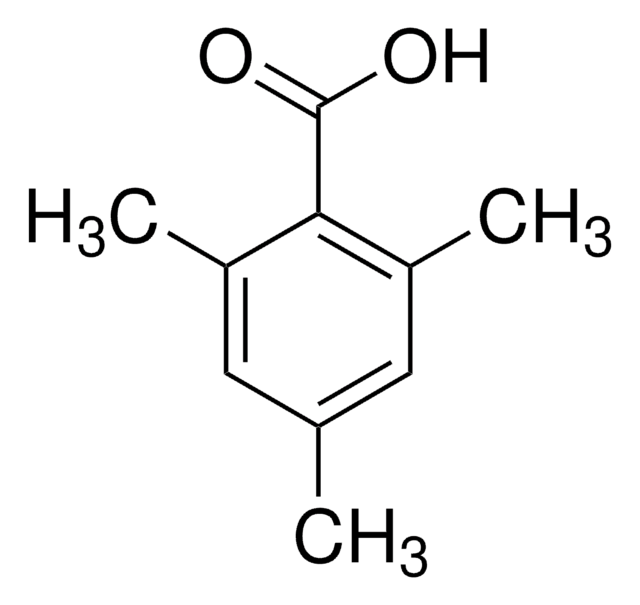140864
Mesitylene
reagent grade, 97%
Synonym(s):
1,3,5-Trimethylbenzene
About This Item
Recommended Products
grade
reagent grade
Quality Level
vapor density
4.1 (vs air)
vapor pressure
14 mmHg ( 55 °C)
2.49 mmHg ( 25 °C)
Assay
97%
form
liquid
autoignition temp.
1022 °F
expl. lim.
0.88-6.1 %, 100 °F
refractive index
n20/D 1.499 (lit.)
bp
163-166 °C (lit.)
mp
−45 °C (lit.)
density
0.864 g/mL at 25 °C (lit.)
SMILES string
Cc1cc(C)cc(C)c1
InChI
1S/C9H12/c1-7-4-8(2)6-9(3)5-7/h4-6H,1-3H3
InChI key
AUHZEENZYGFFBQ-UHFFFAOYSA-N
Looking for similar products? Visit Product Comparison Guide
Application
- Binders for metals in industrial processes: A study explored the use of hydroxyl-terminated dendrimers with sulfonimide linkers, where mesitylene was employed as a critical solvent in the synthesis process, offering potential in industrial metal binding applications (Abu Sbeih and Al Harahsheh, 2024).
- Permeation networks for selective solvent filtration: Research demonstrated the use of mesitylene in creating superoleophilic, chemically and mechanically resistant percolation networks of ZIF-7 and ZIF-11 for the selective permeation of oils and chlorinated solvents, indicating its utility in industrial chemical processes (Prasanthi and Datta, 2023).
- Green synthesis of covalent organic frameworks: A review highlighted the role of mesitylene in the green and facile preparation of covalent organic frameworks, emphasizing its significance in sustainable and advanced applications in chemical engineering (Azadi and Dinari, 2023).
Packaging
replaced by
Signal Word
Danger
Hazard Statements
Precautionary Statements
Hazard Classifications
Aquatic Chronic 2 - Asp. Tox. 1 - Eye Irrit. 2 - Flam. Liq. 3 - Skin Irrit. 2 - STOT SE 3
Target Organs
Respiratory system
Storage Class Code
3 - Flammable liquids
WGK
WGK 2
Flash Point(F)
122.0 °F
Flash Point(C)
50 °C
Personal Protective Equipment
Certificates of Analysis (COA)
Search for Certificates of Analysis (COA) by entering the products Lot/Batch Number. Lot and Batch Numbers can be found on a product’s label following the words ‘Lot’ or ‘Batch’.
Already Own This Product?
Find documentation for the products that you have recently purchased in the Document Library.
Customers Also Viewed
Our team of scientists has experience in all areas of research including Life Science, Material Science, Chemical Synthesis, Chromatography, Analytical and many others.
Contact Technical Service












